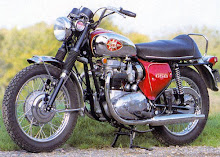
This post is dedicated to one of my faithful readers who didn't give up on me on my hour of need and continued to check in...as a matter of fact he wrote me today..Webster World is an educated and cultured human being whose first riding ..experience was on a 1953 Harley Hummer..so I thought what better than to honor this man and his 1953 Hummer by telling the Hummer story...as it is nowDAYS recorded.
For those of us who do not know...The Hummer is a remnant of the NAZI era.. and the fact that it landed on North American shores is a WAR BOOTY...so here we go with the Hummer story.

The Hummer was a motorcycle model manufactured by Harley-Davidson from 1955 to 1959. However, the name "Hummer" is now used generically to refer to all American-made single-cylinder two-stroke Harley-Davidson motorcycles manufactured from 1948 to 1966. These motorcycles were based on the DKW RT125, the drawings for which were taken from Germany as war reparations after
World War II. RT125 drawings were also given to the United Kingdom and the Soviet Union as war reparations, resulting in the BSA Bantam and the MMZ M-1A Moskva, later known as the Minsk.
In 1948, Harley-Davidson released the Model 125, a small but sturdy two-stroke road machine of 125cc displacement. After the war, America was ready for economical transportation, and the Model 125 was introduced to fill that need.
DKW RT-125
The Model 125's design was an adaptation of the German DKW motorcycles whose engineering designs were forfeited to the Allies as a part of War Reparations at the conclusion of World War II. In America, Harley-Davidson produced the Model 125. In England, BSA made the Bantam. The U.S.S.R, having control of what became East Germany, also appropriated the DKW designs, and made the Mockba M1A. In Japan, Yamaha also got into the act with the YA-1.
The Model 125 put out a whopping three horsepower. One of its more interesting features was a girder-type front end whose suspension consisted of five large rubber bands. In 1951, the rubber band front end was replaced by a more conventional hydraulic unit, the "Tele-Glide".
1953 Model 165
The Model 165 was introduced in 1953 as a replacement for the Model 125. The larger engine size (165cc) boosted horsepower to 5.5. And restyled sheetmetal gave the Model 165 a much cleaner look than its predecessor.
But the 125 wouldn't be out of the picture for long. It was re-introduced in 1955 as the economy model Hummer. Although the Hummer appeared to be a stripped-down version of the 165, the engine had been redesigned. This new "B" model engine would see service through many newer models. A 1955 Hummer weighed 178 pounds, put out 3 1/2 horsepower and sold for $320 F.O.B.
In 1960, the Super-10 emerged, replacing both the Hummer and Model 165. This new model sported a 165cc engine, but it was the "B" engine that had formerly been available in the 125cc Hummer. This would be the end of the road for the Model 165s "S" engine.
Radical changes were in store for 1962. Three models were available. The 165cc Ranger was a stripped down back-woods version similar to the Super-10, and was discontinued after only one year's production. Rear suspension was incorporated in the street Pacer and trailbike Scat, both 175cc versions of the "B" engine.
By 1966, Harley was hard-pressed to compete with the Japanese invasion. The Sprint-series had been introduced five years earlier and the decision was made to shift small-bike production to Italy. One model was produced in 1966, the Bobcat, which sported an innovative fiberglass "body" similar to the one used on the first Superglides a few years later.









































.jpg)












.jpg)














.jpg)



















